Rough Notes: The Real Story From Ballhalla
How the day the Valkyries' season ended, a movement began.
The last/first Valkyries playoff game in the Bay surprised me in ways I couldn’t have even articulated while gridlocked in traffic on the way down to SAP Center in San Jose. (Spoiler: While I started out skeptical, I ended up being fucking obsessed with the experience.) And it made me think about a few things: about Bay Area identities, about vulnerability, about the potency of the Golden State Valkyries as a
brandcommunity.There’s this outside/inside perspective going on with the Valkyries. Mainstream media headlines have attached themselves to the unanimous success of GSV’s marketing. But inside of Ballhalla is a more complex world of Northern California women’s basketball fandom. Beyond the violet masses adorning front pages everywhere is a community that spans both distinct generations and cities. Here, in the sprawling Bay Area (& down to the Central Valley, out past Sacramento, up to Sonoma), people have opened their wallets — and their hearts — to the WNBA… it’s glorious, yes, but also a tender, precarious thing.
A few days after that game in San Jose, after the Valkyries were eliminated from the playoffs, I crowded into the corner of my favorite dive bar with a few friends, sort of to watch another WNBA playoffs game but mostly to process the end of the season. And yes, we talked about that final play between the Valkyries and the Lynx, about why the Valks didn’t foul (?!), but mostly we talked about this inaugural season as a potent form of self-discovery. We talked about our own lives.
We remembered: from what it meant to wear baggy basketball shorts in 1997, to how internalized homophobia crystallizes, to the hauntings of quitting (or never starting) our basketball careers, to the curious fringes of the closeted WNBA world from 15 years ago. We cackled and ranted and at least one of us cried, and I felt so connected to this idea I already knew was true — that what makes women’s basketball so important can’t be measured by just marketing tactics or audience data. That the potency of this fandom comes from its potential for working through old baggage, for rebirth. A new vantage point to re-arrange the whole topography.
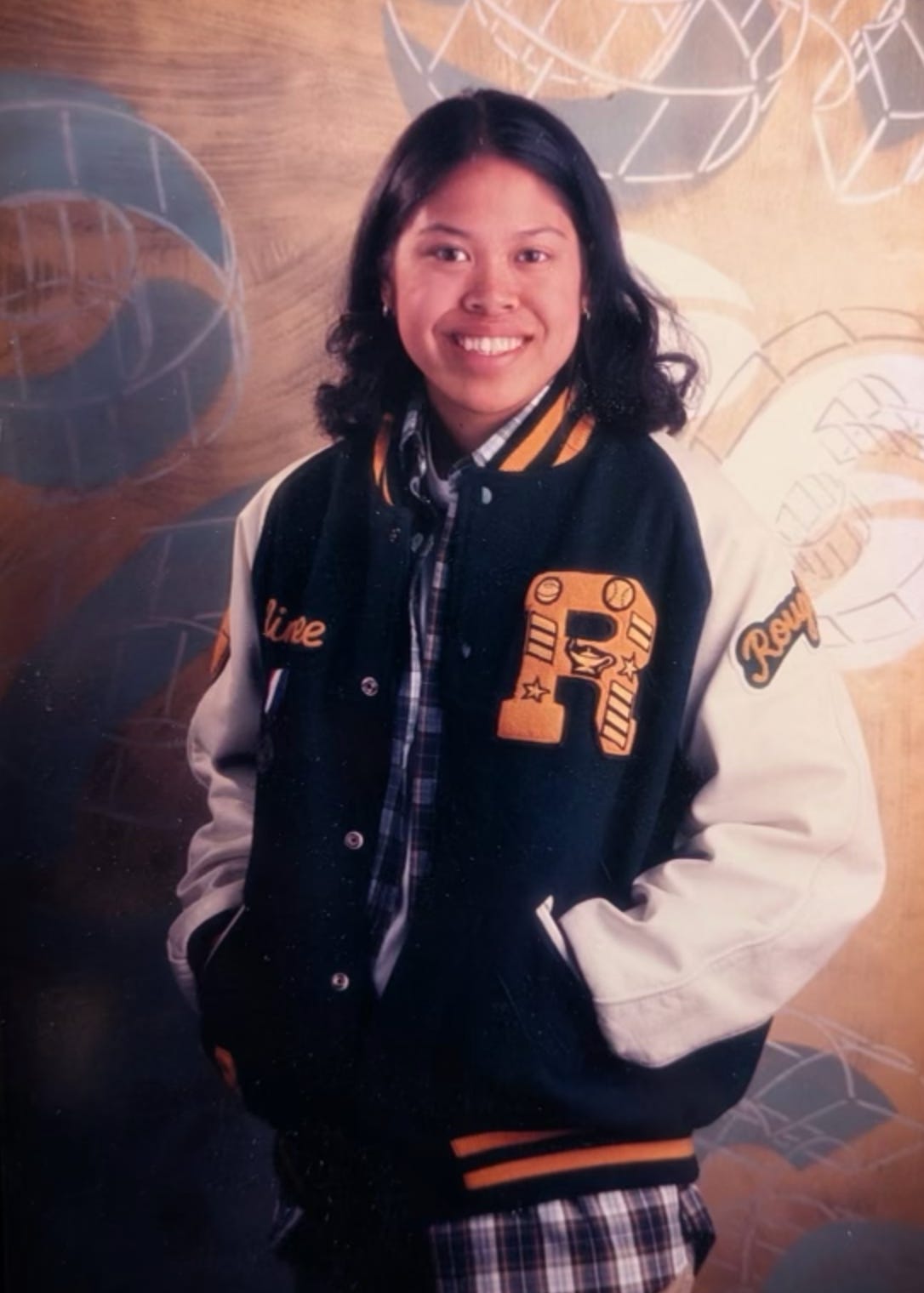
And while I think this is a truly universal WNBA experience right now, I’d also argue that nowhere is this baggage more present than here in Northern California, where all three of our region’s former pro teams — San Francisco Pioneers, San Jose Lasers, Sacramento Monarchs — folded so suddenly that neither teammates nor fans could fully gather to say goodbye. Perhaps the vast majority of Valkyries fans didn’t experience one of these heartbreaks first-hand, but you know who probably did? The loudest elder lesbians in our crowd, aka our fearless leaders. In Ballhalla, these are truly some of the most respected members; when they yell, we follow. (And if you’re not a lesbian, but you’re still from the Bay — particularly the East Bay — then you, too, know sports heartbreak. The loss of pro sports teams is soaked into the DNA of this place!)

I think that’s why it stung so much when we realized, somewhat suddenly, that the Valkyries would not be playing their first-ever playoff game at Chase Center’s home court because of a men’s tennis tournament (apparently booked before the Valkyries bid was even announced.) Perhaps the playoffs were an obvious expectation for players and coaches of Golden State, but that wasn’t effectively communicated by the franchise to the fanbase - meaning that as the Valks clinched their spot in the post-season, moving the game to San Jose came as an abrupt change, a feeling of being slighted, shafted aside. This lingered with me as a kind of grumpiness while heading down to SAP Center, to an arena usually kept at 50 degrees Fahrenheit for the benefit of pro men’s hockey. Did all of this signal something else, something bigger, about the value of the Golden State Valkyries, about our worthiness as a fanbase?
But as soon as I got close to SAP Center, I felt that weight lifting. It started with a sense of familiarity: I found parking in an adjacent residential neighborhood built before the year 2000, walking past one house where three outdoor cats flirted from just beyond the gate. I realized, once stopping in to pee at the nearby & newer Whole Foods, that a lot of folks were coming from San Jose, casually grabbing a snack first at this regular haunt.
Then I joined the block party outside the arena: which was not an overhyped single table in the middle of the artificial grass outside Chase Center, but a bunch of real, free activities stretching down a city block. We mingled around a mini basketball court, inside tents for face painting and several caricature artists, in-line for the Mr. Softee truck, dancing to DJ Lady Ryan as she spun tracks from a booth. In a place where spending money wasn’t the only vehicle for hanging out together, Thrive City became exposed for what it really is: an open-air, upscale shopping center. An outdoor mall. The platonic ideal of Walnut Creek. But re-located to “Ballhalla South,” this fandom came alive for me in a new way.
So many more people seemed to be repping their particular part of the Bay: I watched someone in an old-school Warriors sweatsuit playing knockout, found two friends (& exes) who recognized my Sacramento Monarchs hat and wanted to talk about their 2007 championship, and met a woman whose sign read “Valks #1 Fan From Oakland.” A friend told me about the time they’d started to plan a block party in Thrive City for Pride Night: “I tried to do a real fucking radical drag pop-up with a Black SF drag queen for pride because I’m like, this stilt walker bullshit feels very burning man…” before we got interrupted by running into more friends (so I still really need to hear the end of that story.) I met a couple — Be’Anka & Dap — each born and raised in San Jose, who also happened to have both worked for the ABL’s San Jose Lasers as teens: Be’Anka wiped the floors, while Dap worked a concession stand making nachos and personal sized pizzas. These two should really, actually, have gotten to sit court side.
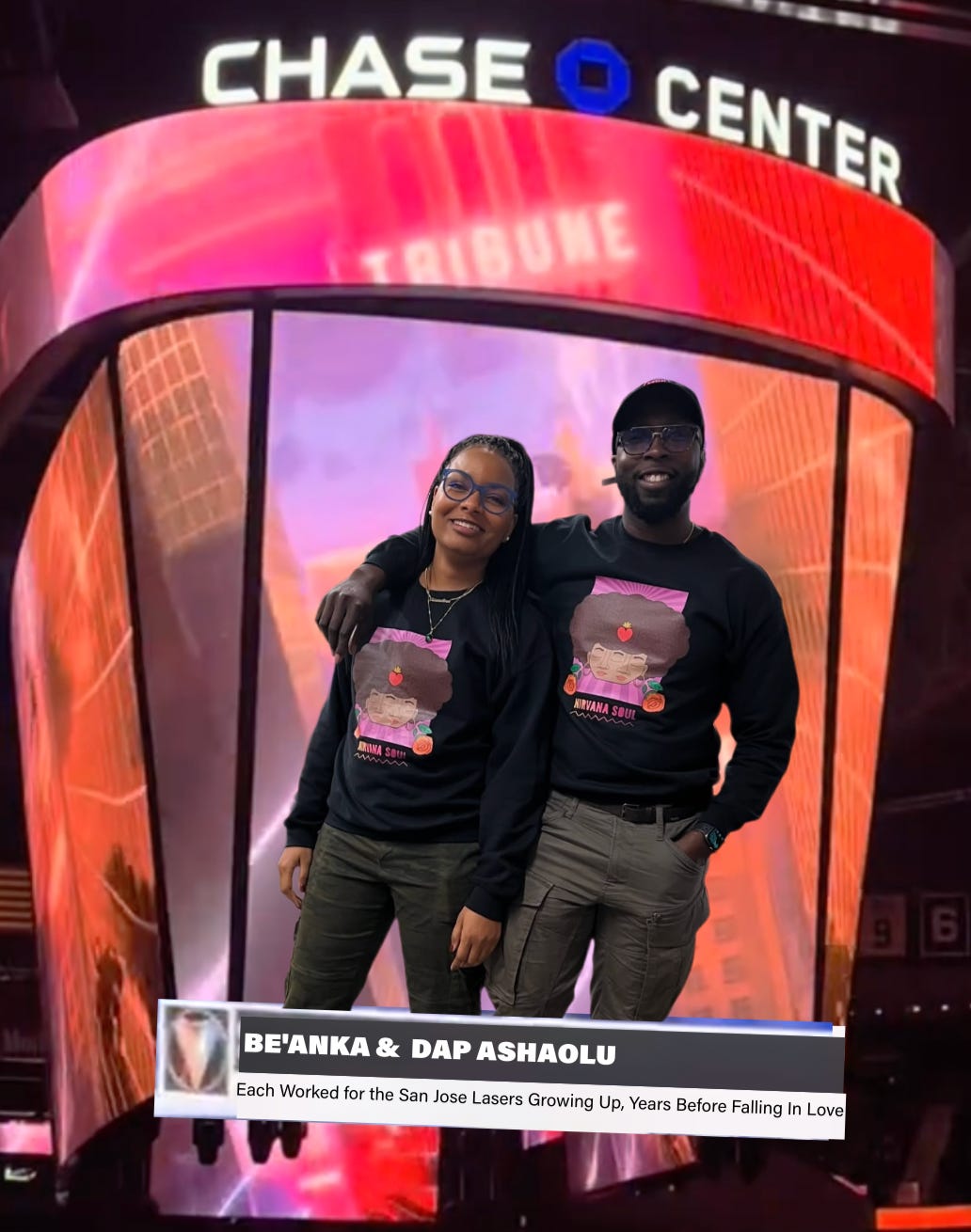
Inside was packed (okay a little more in the 200’s than in the 100’s, smh) and super loud, maybe too loud, and a funny WNBA banner draped awkwardly behind the scorer’s table. Even better, the seats were an ugly light gray that would never be approved by Joe Lacob’s marketing team, and even better: they were worn, fraying a bit at the seams. Lived in.
I realized how much I’ve missed that kind of texture at Valkyries games: not just the gloss, not the Sephora bags floating around to be captured on Instagram, but the texture of the Bay Area and how we know ourselves: as underdogs and misfits, as a mismatched puzzle of cities and towns all crowded around the same body of water, as a collective that has long yearned for more pro women’s basketball than we’ve ever been given. For more queer women’s basketball than we’ve ever been allowed. For new media formats that seemingly break traditional journalism “rules,” but could still potentially mean something to people (aka you.) For the fact that sometimes, the fanciest shit — the lux suites of Chase Center, the front row seats — don’t really matter.
The Valkyries themselves showed similar grit during their first and last home playoff game of the year. The team stood toe-to-toe with the Minnesota Lynx, the most dominant team in the WNBA right now. After losing to Lynx three times in a row going back to the regular season, the Valks — well yes, they lost again, but first they held a lead for nearly the entire game.
The first half was a glorious showcase of the Valkyries’ finest abilities: their gritty, stifling defense, the silky precision of their three-point shooting over the outstretched arms of the Lynx, as though we were skating on the edge of a blade. Like we saw all season, Veronica Burton calmly took hit after hit from the rushing defense while also forcing multiple steals on defense. We matched the Lynx on rebounds. All five Valks starters hit at least one shot from beyond the arc. Kate Martin came off the bench and, with seconds in the 2nd quarter, hit a corner perfectly-executed triple axel. By halftime, Golden State was up by 13, punching Minnesota down to just 28 points in the first half, their lowest of the season.
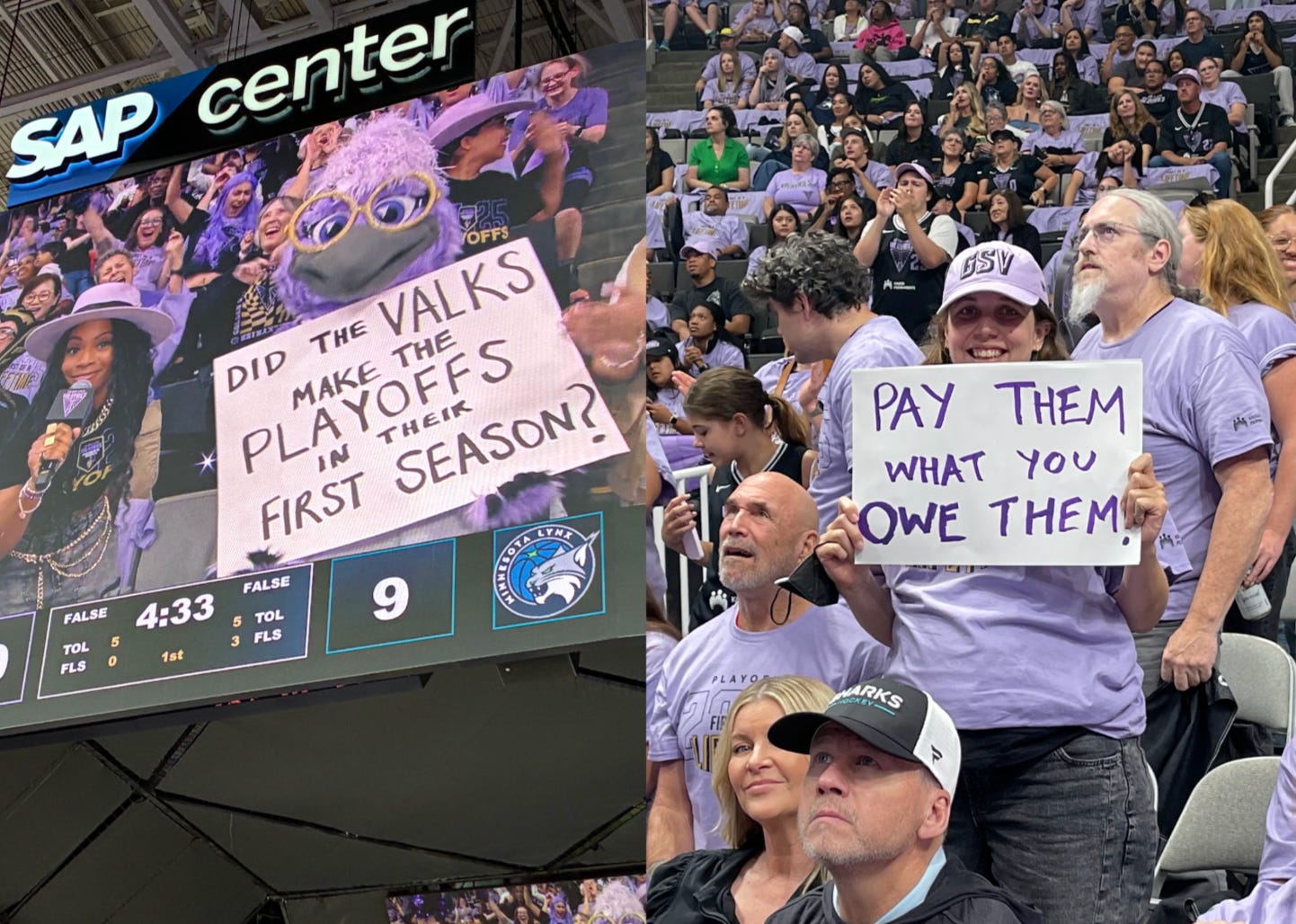
the bay area loves signs. but they gotta put more political ones on the jumbotron ;) for more on my thoughts about wnba players’ current struggle for equal pay, read here. The fourth quarter was a different story. A familiar unraveling: the underdog Valkyries caught by the Lynx like a cornered animal. And yet, after losing the lead late in the game, coach of the year Natalie Nakase and her team still found a way to contend for that final shot, numbing the Lynx into a shot clock violation before Cecilia Zandalasini narrowly missed an open look from the elbow (we love you, Ceci.) Afterwards, of course, the crowd stayed, chanting “G-S-V” around the huddled Valkyries team at center court. Because despite the loss, what we recognized most was the presence of potential. Of movement, and change. Or as Valkyries poet laureate Temi Fagbenle just posted to Instagram about the inaugural season:
“We gotta start the rumble! One game a season here, one game a season in Oakland!” I heard someone shout before the last/first game even started. And I wholeheartedly agree (s/o to Oakland Arena, hopefully soon purchased successfully by the African American Sports & Entertainment group.) But I especially love the notion that we really gotta keep starting new rumbles. The momentum of locating ourselves, 18,000 fans per game & the belles of the WNBA PR ball, as possessing our own power. That away from the manufactured culture of Chase Center, Valks’ fandom might actually clarify its presence as a community-based culture.
Which is all to provoke you with the following questions: what can happen in this off-season, when we are no longer neutralized by a sterile meeting point in the developed neighborhood of “Mission Bay,” but out in the wilds of distinct Bay Area places? Might this be how we feel our Valkyries pride, our determination, our purpose surging?
After the surprising success of that last/first game in San Jose, I think Valkyries fans are coming to understand that Ballhalla, just like the Bay Area, is not one place: it truly is a mentality. And just like the Valkyries front office, we too have choices to make this off-season — what to process & take away from our first WNBA team, how we understand women’s basketball history and its radical possibilities during this current WNBA moment, about what our demands of the Golden State franchise might now be. Ultimately, it’s the Bay Area community that defines the still-becoming legacy of the Golden State Valkyries. It’s about how women’s basketball reveals who we are to ourselves.
ok, this audio clip is too long but lmao the “oh my god” at the end




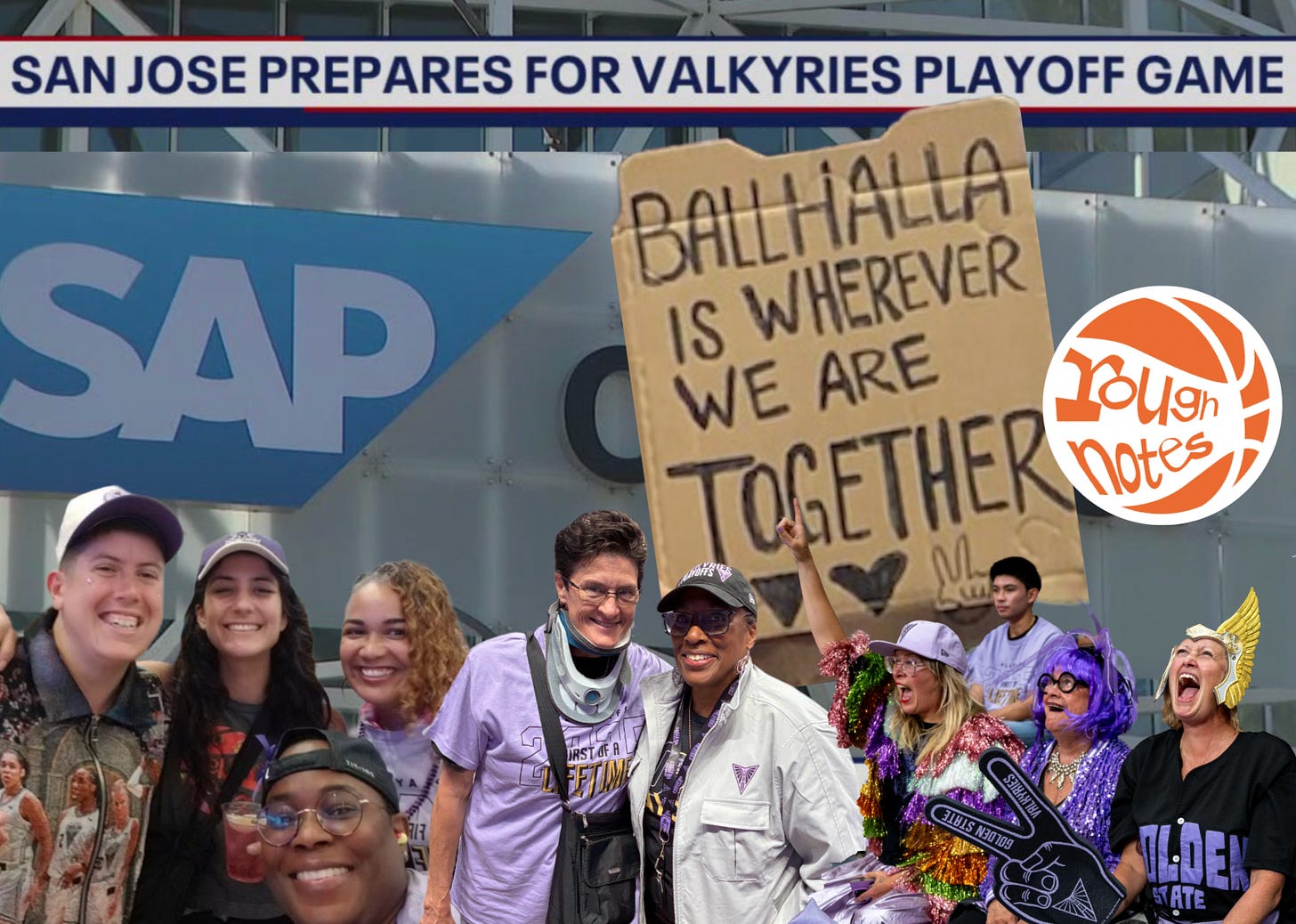

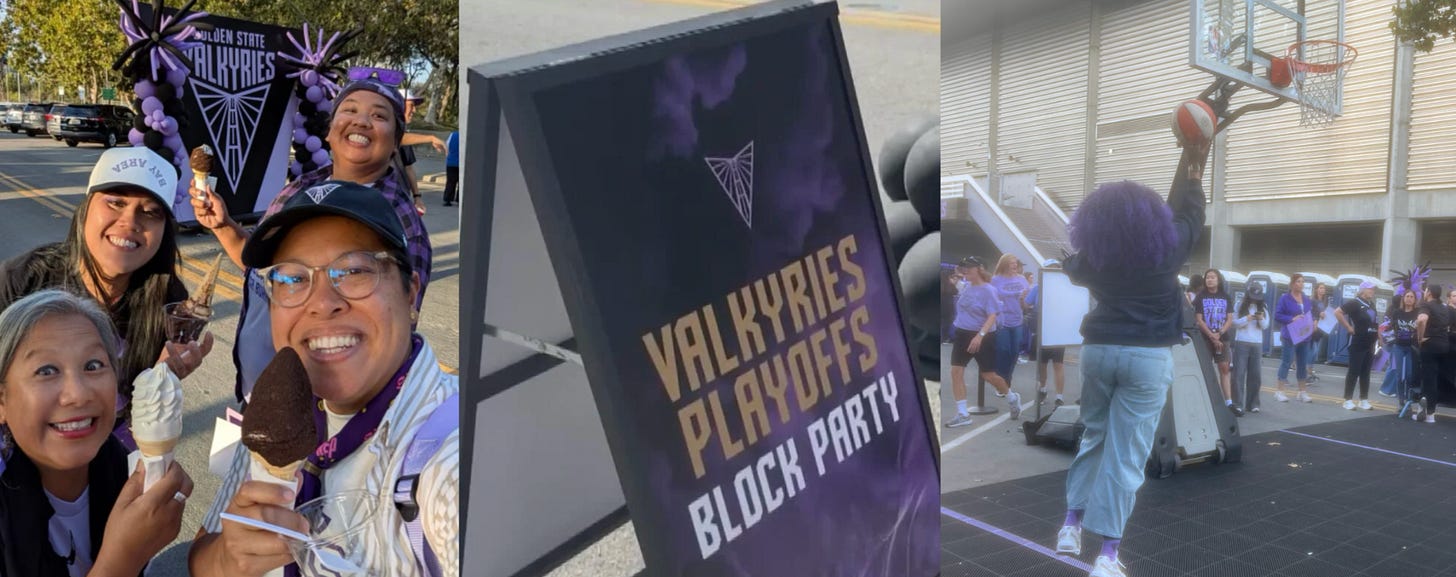
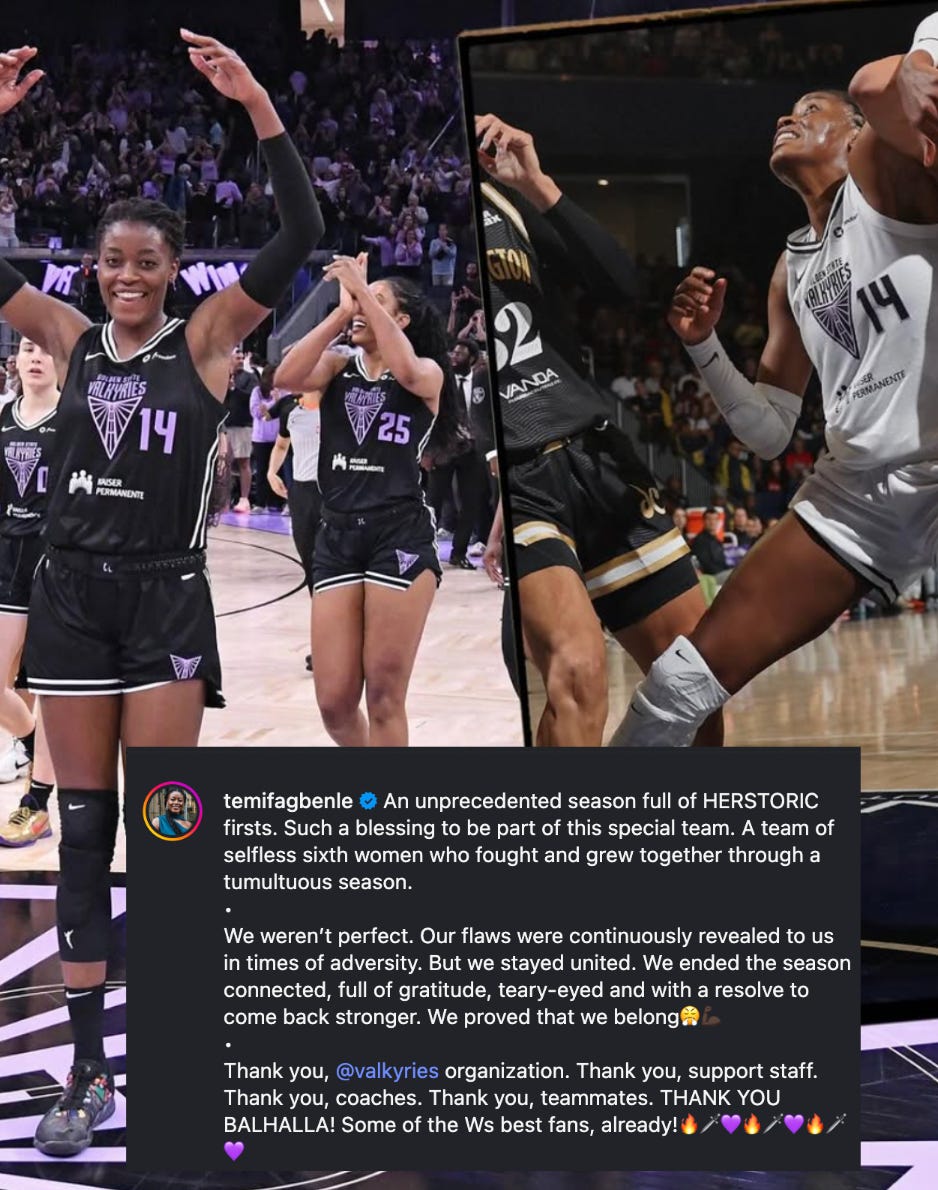
Great piece. I hope the enthusiasm will carry over to our local women’s college basketball offerings. Cal, Stanford, St. Mary’s, Santa Clara, USF…and more. High school games are fun too! Lots to celebrate and enjoy in the Bay Area…
Good stuff, Maya (we met on Bart on the way to a game)!